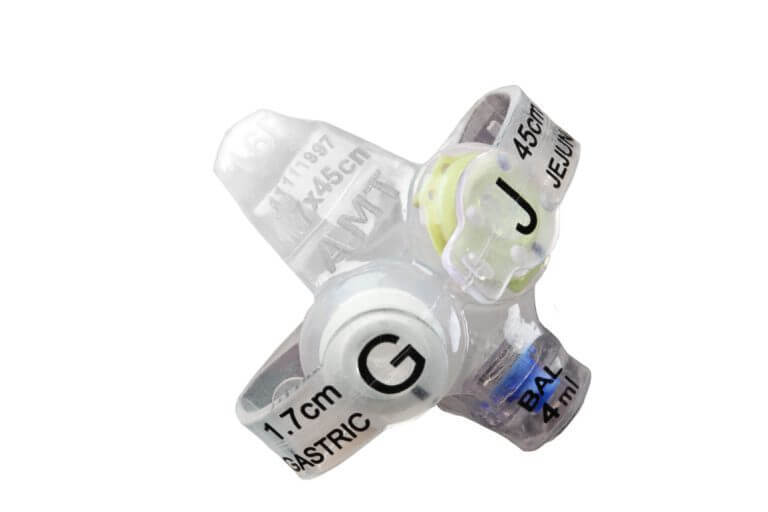
Product Specifications
AMT G-JET® Button Anatomy
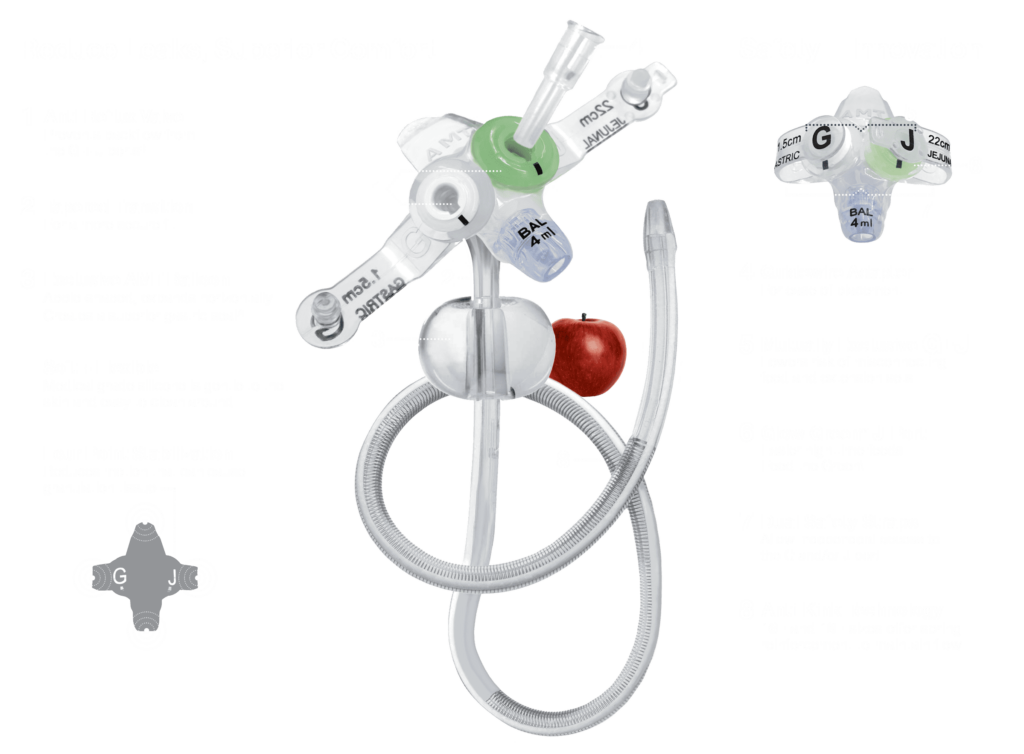
Enhanced Features
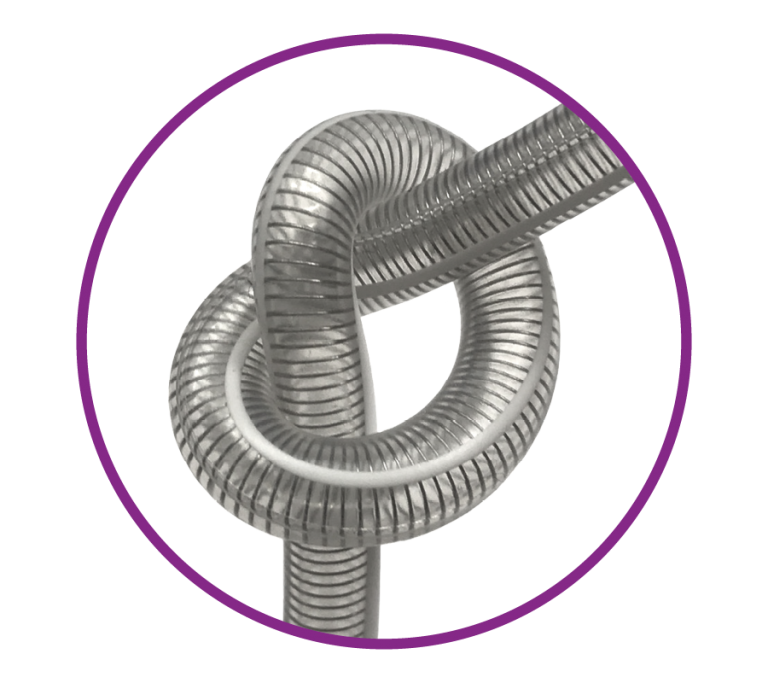
Anti-Kink Technology*
Spring reinforcement stabilizes the jejunal lumen to help reduce kinking and clogging.
*Only in 16F & 18F Devices
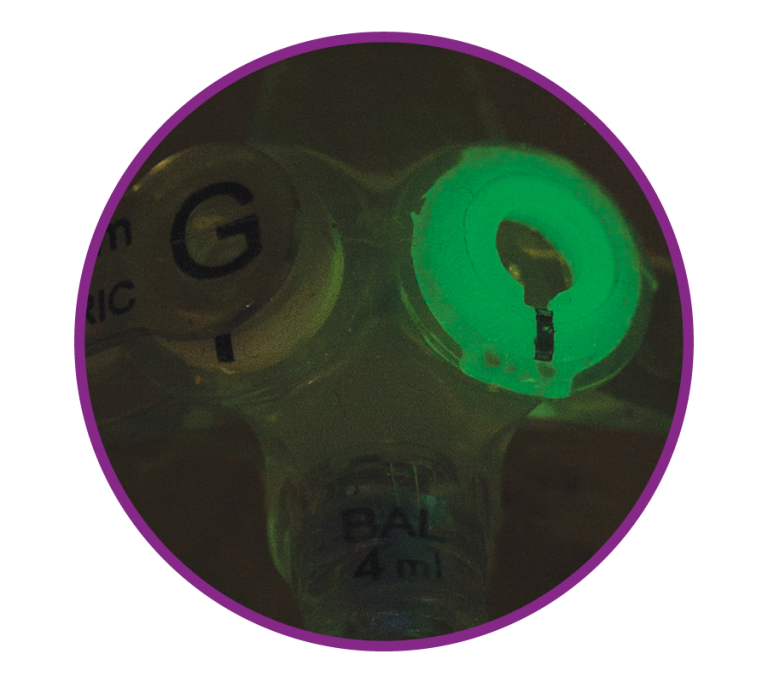
Easier Nighttime Connections
Jejunal port and jejunal connector glow-in-the-dark.
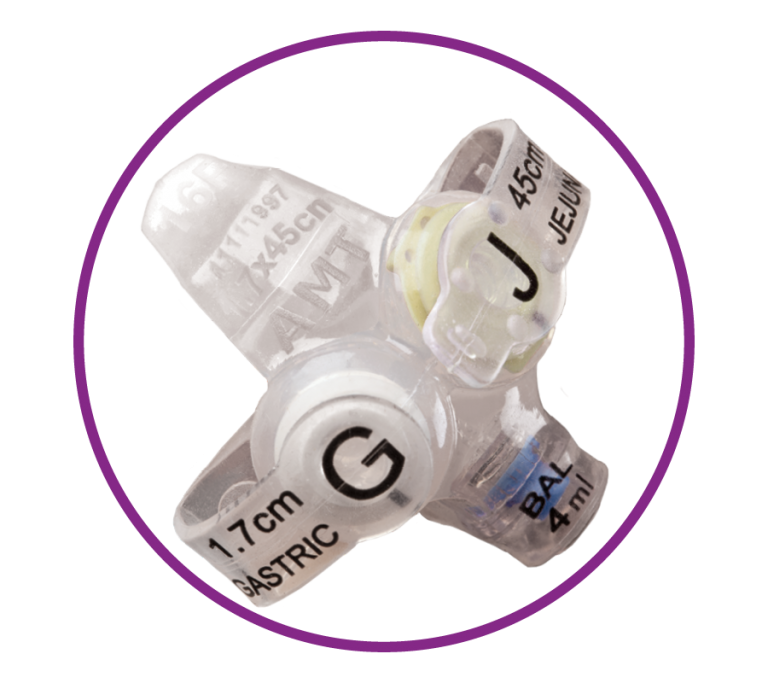
Reduced Risk of Misconnections
Clearly labeled with distinctive shapes & exclusive ports.
Click here to download the G-JET® brochure.
G-JET® Benefits: Reduced Clogging*
AMT has addressed device clogging by developing a unique internal tube structure. Unlike other GJ tubes, the AMT G-JET® transitions from a tri-lumen design in its proximal (gastric) segment to one functional lumen in its distal (jejunal) segment.
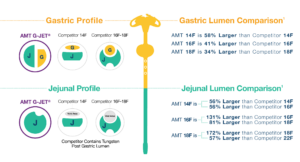
The design of the AMT G-JET®’s jejunal lumen supports increased flow. The lumen offers a larger cross-sectional area and eliminates all sharp corners and small spaces in the jejunal portion to help prevent clogging.
With less clogging, fewer tube replacements may be required.
*Tube longevity based upon field research.
G-JET® Button Gastric + Jejunal Sets
Part Numbers & Ordering Information
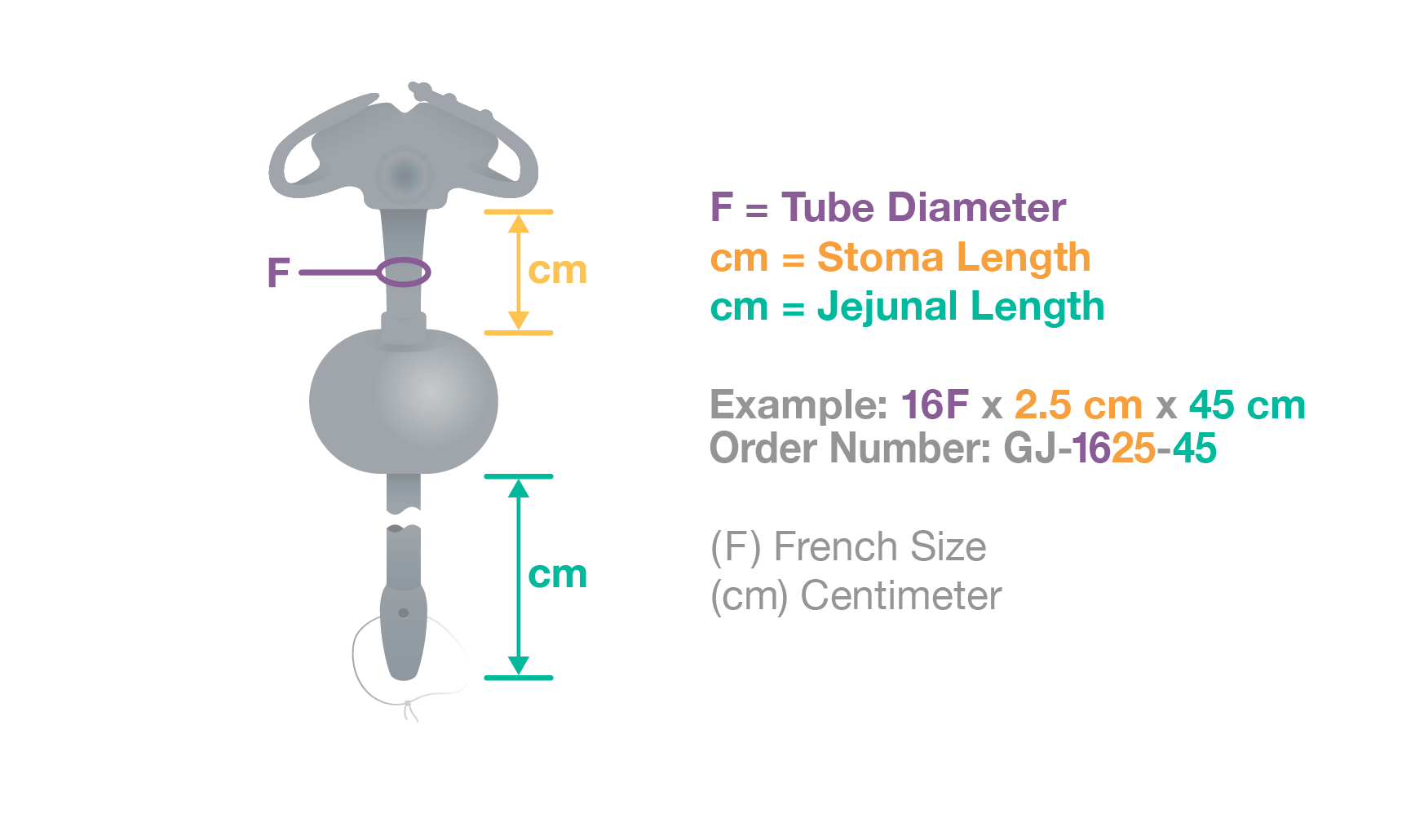
The AMT G-JET® Low Profile Gastric-Jejunal Enteral Feeding Tube is available in 14F, 16F, & 18F.
NOTE: The AMT G-JET® may be placed percutaneously under fluoroscopic or endoscopic guidance or as a replacement to an existing device using an established stoma tract. Placement/Removal is to be performed by a qualified clinician.
NOTE: G-JET® devices should never be cut to custom lengths.
The G-JET® Button is cleared for initial placement and is MR Conditional.
NOTE: G-JET® devices should never be cut to custom lengths.
The G-JET® Button is cleared for initial placement and is MR Conditional.
NOTE: G-JET® devices should never be cut to custom lengths.
The G-JET® Button is cleared for initial placement and is MR Conditional.
G-JET® Button Gastric + Jejunal Sets
As an added safety feature, the AMT G-JET® has mutually-exclusive ports! This means the gastric extension set will ONLY properly lock into the gastric (white) port, while the jejunal feed set will ONLY properly lock into the jejunal (glow green) port.
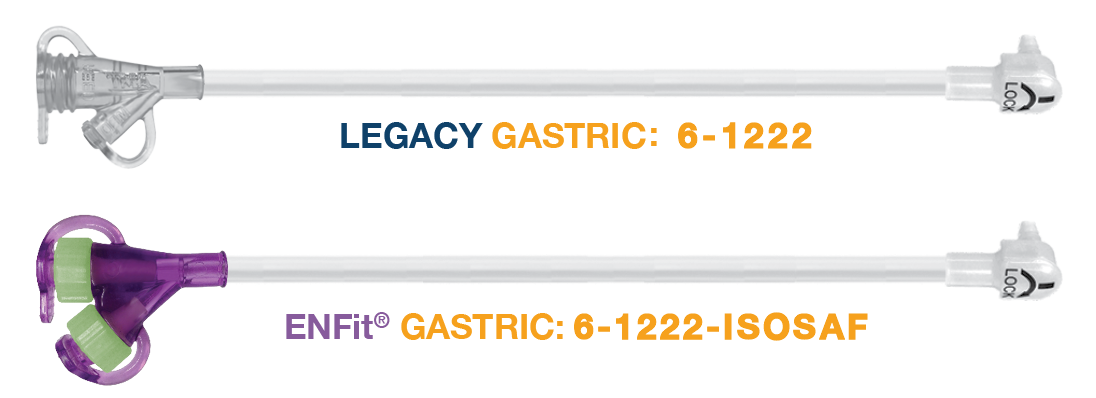
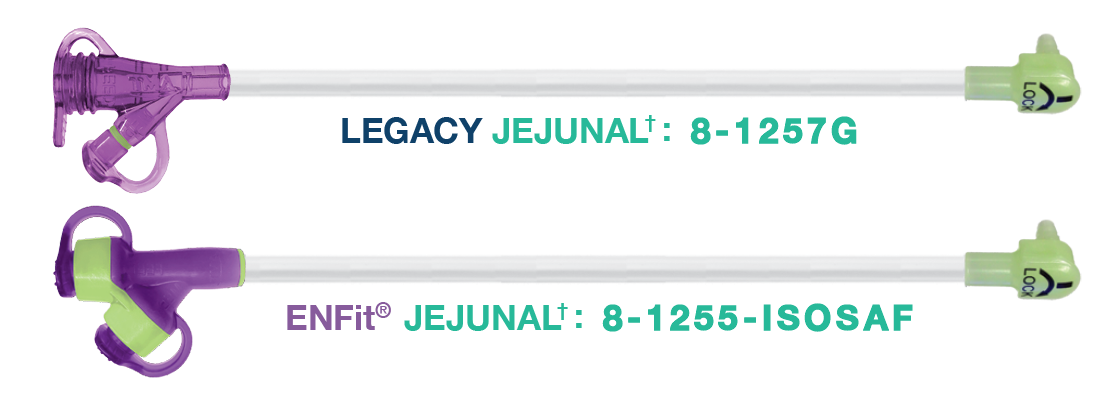
How to Attach a Feed + Extension Set:
AMT’s G-JET® Feed + Extension Sets lock into place with a simple turn!
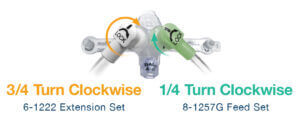
Dual Extension Set & Feed Set Hook-Up
Frequently Asked Questions
AMT has provided this information as an educational resource tool. This is not intended as a substitute for professional medical care. Your FIRST source of information should be your healthcare provider.
What should I do if there is leakage around my device?
- Make sure the balloon is filled with the prescribed amount of water (resistance should be felt when gently pulling on the tube.) NOTE: The recommended fill volume is printed on top of the fill valve. If you have questions, contact your healthcare provider.
- Check that the G-J tube corresponds to the prescribed French size and length. If the incorrect device is in place, call your doctor.
- The G-J tube may be too tight or too loose. Call your doctor to have the stoma remeasured.
For new placements, it may take time for the stoma tract to naturally heal, firm up around the tube, and conform to the balloon. If leaking persists, contact your healthcare provider. - With each placement, the stoma length should be measured with the AMT Stoma Measuring Device.
- Causes for Leakage:
- Incorrect size
- Weight change
- Amount of water in balloon may be too much or too little
- Tension at stoma site
- Stomach may need to be decompressed
How do I address balloon-related concerns?
BALLOON FAILURE:
- A balloon may leak or deflate over time due to medications, balloon inflation volume, stomach acid, G-tube care, or natural wear. ALWAYS have a spare G-tube, like the AMT’s MiniONE® Balloon Button, to place in the stoma tract that is similar in size to your G-JET® device. This will aid in keeping the stoma tract from closing. Once a temporary replacement device is in place, call your doctor.
Do NOT remove G-J tube until a replacement is available in order to prevent the stoma from closing.
BALLOON WILL NOT DEFLATE:
- Clean the balloon port with a cotton swab to make sure formula/medication or other contaminants are not blocking the balloon port. Insert a slip-tip syringe, push and twist one-quarter turn. If the balloon still will not deflate, please contact our Enteral Product Specialists by calling 800-869-7382. If the problem persists, call your doctor.
What should I do if the feeding set disconnects?
Stop the feeding pump and estimate the amount of formula lost. Wipe tube connections thoroughly with soap and water. Clean the inside of the feed set and the device feeding port with a clean cotton swab and soap and water. Dry connectors and reconnect tubes. Resume feeding, adding additional formula for the estimated loss.
How can I prevent tube blockage/clogging?
- Flush the G-J tube with 5ml (10-20ml for adults) of warm water before and after administering food or medication or every 6 hours for continuous feeding. DO NOT place foreign objects down the center of either port on the G-J tube.
- DO NOT mix medications with formula while feeding. Always administer medications one at a time and thoroughly clean the extension set. Try to obtain your medications in liquid form when possible. If only available in tablet form, ask your pharmacist if it is safe to crush the tablet into a fine powder and mix with warm water.
How do I know if the GJ is too tight against the patient’s skin?
The G-J tube should be able to move slightly from side to side easily without resistance from the patient’s skin. If the G-J tube does not move easily or redness/bleeding occurs at the stoma site or the area directly underneath the G-J tube, call your doctor. The patient may need to be remeasured for a longer G-J tube.
With each placement, the stoma length should be measured with the AMT Stoma Measuring Device.
What do I do if the GJ is pulled out of the patient?
Although the G-J tube is designed to decrease the number of pullouts, a G-J tube may become accidentally dislodged. ALWAYS have a spare G-tube, like the AMT’s MiniONE® Balloon Button, to place in the stoma tract that is similar in size to your G-JET® device. This will aid in keeping the stoma tract from closing. Once a temporary replacement device is in place, call your doctor.
What should I do if vomiting occurs?
Contact your healthcare provider if you or your patient are experiencing vomiting.
Aspiration (inhalation of food or stomach contents into the lungs) may occur while vomiting, causing difficulty in breathing or other serious medical conditions. Stop feeding and decompress the stomach immediately if vomiting occurs.
CONTACT EMERGENCY CARE IMMEDIATELY IF DIFFICULTY IN BREATHING OCCURS, OR ASPIRATION IS SUSPECTED. DO NOT FEED WHILE THE PATIENT IS LYING FLAT.
What should I do for diarrhea?
Contact your healthcare provider if you or your patient are experiencing Diarrhea.
This may occur if formula has spoiled. Mix new formula before each feeding. Cleanliness is also very important. ALL CAREGIVERS SHOULD WASH THEIR HANDS THOROUGHLY PRIOR TO PREPARING THE FORMULA AND HANDLING THE FEED SETS. Make sure the feeding sets are rinsed thoroughly to avoid soap in the formula. Call your doctor if diarrhea continues.
How do I care for constipation occuring?
Contact your healthcare provider if you or your patient are experiencing constipation.
This may occur due to dehydration, inactivity, feeding routine, or change in formula or medication. Call your doctor if this continues.
Why is my stomach upset?
This may occur if too much formula is administered or if the formula is delivered too quickly. Call your doctor if this continues.
When should I contact a physician regarding device or stoma concerns?
Contact your physician if any of the following are observed:
- If the skin around the stoma is red or raw
- If there is drainage around the site that is white, yellow, or green
- If drainage from the site has a foul odor
- If crusting is noted at the site
- If repetitive leakage of food or stomach contents (gauze or pads should not be necessary)
- If there is pain at the G-J stoma site
- If there is bleeding, puss, or inflammation at the G-J stoma site
If the tube begins to migrate or becomes dislodged, immediately consult your physician.
If the tube completely falls out of the stoma tract, your physician may suggest that you temporarily place a G-tube in the stoma tract to aid in keeping it from closing until a new G-JET device can be placed. For this reason, it may be helpful to always keep a spare g-tube on hand, like AMT’s MiniONE® Balloon Button.
1. Claim based on internal testing of 14F-22F devices.
2. Claim based on internal testing of 16F devices.
ENFit® is a registered trademark of GEDSA, Inc. or its affiliates.
 Order Info
Order Info